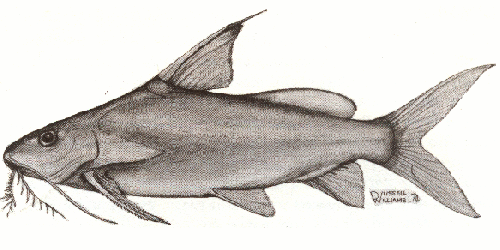 The
wonderful "Choka Chok". (The singing fish) There are lots of different
types but generally the "brown squeaker" is the most commonly caught species)
The
wonderful "Choka Chok". (The singing fish) There are lots of different
types but generally the "brown squeaker" is the most commonly caught species)
Mostly caught on worm by accident whilst fishing for something else, and occasionally on kapenta.
They tend to hang around the bigger trees in the dirty water in the rivers, as they appear to live in the root systems where these have been exposed, or in holes or depressions in the river beds.
They are mainly a dark area fish and grovel in the bottom for any food they can find. When the water clears up they simply appear to go deeper or under weed mats, and spread out more.
Again a few handfuls of kapenta chummed over the side will bring in a few roaming fish. Often where there are a lot of them there will be lots of small bubbles popping up now and again all over the place, a sign that they are grovelling in the bottom looking for food.
There are quite a few types of squeaker so do not be surprised if you catch different looking ones.
(Although caught easily by accident, the "Pro's" seem to find them hard to catch most of the time, maybe because of the qualifying weight they require)
These fish do have very sharp spines with
barbs and they are very hard to remove once they are in your hand or foot.
The spines are tough and if you are keeping them, handle with care and
cut off the spines as for Silver Barbel. Competitive anglers often put
the spines back into the mouths in an effort to try and save the weight
of a few grams during competitions.
The recommended way to get them out
if they are really bedded in, is to (if possible and there is no sense
no feeling) cut them at the entry point and push right through. Less of
the "gunge" behind the barbs comes off this way. IMMEDIATELY treat with
a good antiseptic after thoroughly flushing/cleaning.